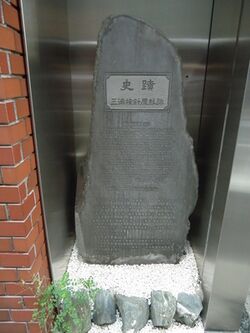Difference between revisions of "William Adams"
| Line 10: | Line 10: | ||
Adams dreamed of returning to England, but the government would not let him. He became a ''[[hatamoto]]'' and was given land in the Miura Henmi (三浦逸見) district of [[Sagami province]] (near the mouth of [[Edo Bay]]), along with 80 servants,<ref>Gonnami, Tsuneharu. "[https://circle-prod.library.ubc.ca/bitstream/handle/2429/21181/Images_of_foreigners.pdf?sequence=1 Images of Foreigners in Edo Period Maps and Prints]." Unpublished manuscript. Presentation at symposium "Edo: Past & Present," University of British Columbia, April 1998. p7.</ref> and so was called Miura Anjin (三浦按針), ''anjin'' meaning "pilot." Though he was married to an Englishwoman, he also married a Japanese woman, the daughter of a headman of a post-station, and maintained a concubine in [[Hirado]]. | Adams dreamed of returning to England, but the government would not let him. He became a ''[[hatamoto]]'' and was given land in the Miura Henmi (三浦逸見) district of [[Sagami province]] (near the mouth of [[Edo Bay]]), along with 80 servants,<ref>Gonnami, Tsuneharu. "[https://circle-prod.library.ubc.ca/bitstream/handle/2429/21181/Images_of_foreigners.pdf?sequence=1 Images of Foreigners in Edo Period Maps and Prints]." Unpublished manuscript. Presentation at symposium "Edo: Past & Present," University of British Columbia, April 1998. p7.</ref> and so was called Miura Anjin (三浦按針), ''anjin'' meaning "pilot." Though he was married to an Englishwoman, he also married a Japanese woman, the daughter of a headman of a post-station, and maintained a concubine in [[Hirado]]. | ||
| − | Adams was granted a [[shuinsen|red seal trading license]] by the shogunate, and traveled to [[Ayutthaya]] (Siam) on several occasions in [[1615]]-[[1616]], aboard his ship the ''[[Sea Adventure]]'' | + | Adams was granted a [[shuinsen|red seal trading license]] by the shogunate, and traveled to [[Ayutthaya]] (Siam) on several occasions in [[1615]]-[[1616]], aboard his ship the ''[[Sea Adventure]]'',<ref>Geoffrey Gunn, ''History Without Borders: The Making of an Asian World Region, 1000-1800'', Hong Kong University Press (2011), 223.</ref> as well as to [[Hoi An]] (in Vietnam) in [[1617]]. |
He died of illness in Hirado in [[Hizen province]], where the Dutch, English, and Portuguese all maintained bases, in [[1620]]. There is a grave in Henmi (now [[Yokosuka]] City), called "Anjin-zuka" and said to be his. Following Adams' death, his son continued to trade for a time under the name "Miura Anjin," employing his father's red seal license.<ref>[[Marius Jansen]], ''China in the Tokugawa World'', Harvard University Press (1992), 19.</ref> | He died of illness in Hirado in [[Hizen province]], where the Dutch, English, and Portuguese all maintained bases, in [[1620]]. There is a grave in Henmi (now [[Yokosuka]] City), called "Anjin-zuka" and said to be his. Following Adams' death, his son continued to trade for a time under the name "Miura Anjin," employing his father's red seal license.<ref>[[Marius Jansen]], ''China in the Tokugawa World'', Harvard University Press (1992), 19.</ref> | ||
Revision as of 20:28, 25 September 2015

William Adams, also known as Miura Anjin, was an English navigator who settled in Japan. He is now famous as the prototype of the hero of James Clavell's quasi-historical novel Shogun.
Adams was pilot of the Dutch ship Liefde which arrived at Bungo province in Kyushu on April 19, 1600. By the order of Tokugawa Ieyasu, then the chief tairô (senior counsellor), Adams was brought to Osaka as representative of the crew. He had an interview with Ieyasu on May 12[1] and apparently favorably impressed him. After that Adams served Ieyasu in a number of fields, even building him an 8-ton European-style boat. He also served as interpreter and as an agent for the Dutch and English East India Companies, and played a role of no small importance in shaping the position of the bakufu towards Spain, Portugal and the Catholic Church.
Adams dreamed of returning to England, but the government would not let him. He became a hatamoto and was given land in the Miura Henmi (三浦逸見) district of Sagami province (near the mouth of Edo Bay), along with 80 servants,[2] and so was called Miura Anjin (三浦按針), anjin meaning "pilot." Though he was married to an Englishwoman, he also married a Japanese woman, the daughter of a headman of a post-station, and maintained a concubine in Hirado.
Adams was granted a red seal trading license by the shogunate, and traveled to Ayutthaya (Siam) on several occasions in 1615-1616, aboard his ship the Sea Adventure,[3] as well as to Hoi An (in Vietnam) in 1617.
He died of illness in Hirado in Hizen province, where the Dutch, English, and Portuguese all maintained bases, in 1620. There is a grave in Henmi (now Yokosuka City), called "Anjin-zuka" and said to be his. Following Adams' death, his son continued to trade for a time under the name "Miura Anjin," employing his father's red seal license.[4]
There is a marker on the site of his Edo (now Tokyo) mansion; the address is Chûô-ku, Nihonbashi Muromachi 1-10-8. Until the beginning of the Shôwa Period (1926-1989) the area was called "Anjin-chô"; there is still an "Anjin-dôri" ("Anjin Street") there. There is also an annual festival in his honor, held in Itô, Shizuoka Prefecture, called Anjin Matsuri.
Notes
- ↑ Adams gave this date in a letter to his wife. It is not clear if he was using the Gregorian or the Julian calendar. It seems most likely that as he came on a Dutch ship he would be using the calendar of the log of that ship, presumably the Gregorian one (see http://webexhibits.org/calendars/year-countries.html). This would mean the date he he saw Ieyasu was 1600/3/29 (Japanese calendar). However, England was still using the Julian calendar. If Adams as an Englishman used the Julian calendar, he would have met Ieyasu on 1600/4/10.
- ↑ Gonnami, Tsuneharu. "Images of Foreigners in Edo Period Maps and Prints." Unpublished manuscript. Presentation at symposium "Edo: Past & Present," University of British Columbia, April 1998. p7.
- ↑ Geoffrey Gunn, History Without Borders: The Making of an Asian World Region, 1000-1800, Hong Kong University Press (2011), 223.
- ↑ Marius Jansen, China in the Tokugawa World, Harvard University Press (1992), 19.